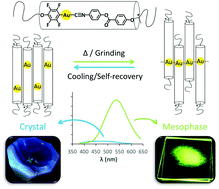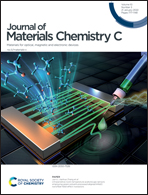Access to luminescent mesophases of chiral gold(i) complexes by thermal or mechanic stimuli: the role of the tertiary carbon†
Abstract
Chiral gold(I) isocyanide complexes [Au(p-C6F4OR1)(p-CNC6H4(O2CC6H4OR2)] with R1, R2 or both being (R)-2-octyl, display an interesting and unprecedented response to mechanical or thermal stress. For all the complexes, heating leads to formation of Sm mesophases identified by POM, DSC, and X-ray diffraction studies. On the other hand, grinding produces soft materials which are eventually identified also as Sm metastable mesophases formed at temperatures much below the melting point. Intriguingly, only some of these mesophases (those with the tertiary carbon in the isocyanide ligand) display a strong green luminescence. The X-ray analysis supports that the melting of the crystals, either by mechanical or by thermal stress, produces a transition from regular Sm-like molecular arrangement in the solids to interdigitated-Sm arrangement in the mesophases. The molecular slippage producing this interdigitation is conditioned by the position of the bulky tertiary carbon in the molecule, which allows or impedes formation of the Au⋯Au interactions that give rise to luminescence.



 Please wait while we load your content...
Please wait while we load your content...